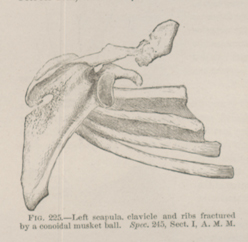Title: L——, Edward
Source text: Surgeon General Joseph K. Barnes, United States Army, The Medical and Surgical History of the War of the Rebellion. (1861–65.), Part 1, Volume 2 (Washington, D.C.: Government Printing Office, 1870), 486.
Civil War Washington ID: med.d1e19368
TEI/XML: med.d1e19368.xml
CASE.—Private Edward L——, Co. A, 87th New York Volunteers, was wounded at Bull Run, August 27th, 1862, by a conoidal musket ball, which struck the left clavicle about three inches from its sternal extremity, passed through the chest, and emerged near the posterior border of the left scapula. Five days subsequently he was admitted into the Cranch Hospital at Washington, in a feeble condition. There was constipation and troublesome cough accompanied by hæmoptysis. The bowels were relieved by sulphate of magnesia, and the cough was alleviated by ipecac and opium. An engorged condition of the injured lung, with sanguineous expectoration and dyspnœa, continued for some twelve days, when the patient began to grow better. His general health improved, and, to all appearance, resolution was taking place in the lung. Improvement continued till October 12th, when the patient took cold through indiscretion, and had a chill. After appropriate treatment he had partially recovered by October 27th, when he again exposed himself unnecessarily, took a fresh cold, and had another chill, lasting an hour and a half, followed by fever and pneumonia of the right lung. Wet cups were now applied, and a dose often grains of calomel was administered. On October 30th, the cups were repeated, and another expectorant mixture was prescribed. There was no reaction, however, dyspnœa continuing unabated, and terminating in death on November 3d, 1862. The autopsy showed the left clavicle fractured at the junction of the middle with the outer third, the distal portion being driven in. There was a formation of callus, but no union of bone. The third, fourth, and fifth ribs, of the left side, were fractured near their spinal articulations, and the dorsum of the left scapula was perforated. The apex of the left lung was grooved by the passage of the ball and appeared entirely solidified. The track of the wound through the lung was entirely cicatrized, and seemed cartilaginous to the touch. There were also pleuritic adhesions in the right side, and the right pleural cavity contained from two to three pints of fluid. The specimen, represented in the adjoining wood-cut, FIG. 225, was contributed to the Army Medical Museum, with the history, by Surgeon A. Wynkoop, U. S. V.


